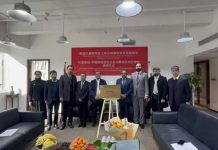LHASA: As the first rays of sunlight bathed the ancient city of Lhasa, the capital of southwest China’s Xizang Autonomous Region, a residential compound was filled with traditional new year greetings in different languages — “Chunjie Kuaile” (meaning “Happy Spring Festival” in Mandarin) and “Losar Tashi Delek” (meaning “Happy New Year” in Tibetan).
The compound named Ngangpa Kangchung, a Tibetan-style residence in downtown Lhasa, is home to some 70 residents from Han, Tibetan, Hui and other ethnic groups.
As the Tibetan New Year coincided with the Lunar New Year, also known as the Spring Festival, on Saturday this year, residents in the multicultural compound savored delectable traditional dishes of different ethnic groups and celebrated the two festivals together.
Sun Jianxue and his wife Sonam Badran treated their visiting neighbors with “chema,” a wooden box filled with colorful grains and barley flour, symbolizing good luck and prosperity in Tibetan culture.
“Neighbors from various ethnic groups of the compound have integrated deeply, just like butter and tea leaves in buttered tea,” said Sun, 62.
Sun, a Han retired road construction worker from Gansu Province, married his Tibetan wife 34 years ago when he worked in Xizang. Over the years, he has developed a taste for Tibetan food like tsampa and buttered tea. He also got used to making traditional fried snacks for the Tibetan New Year.
On Saturday, Sun cooked beef noodles, a specialty of his hometown, for his family. –Agencies




